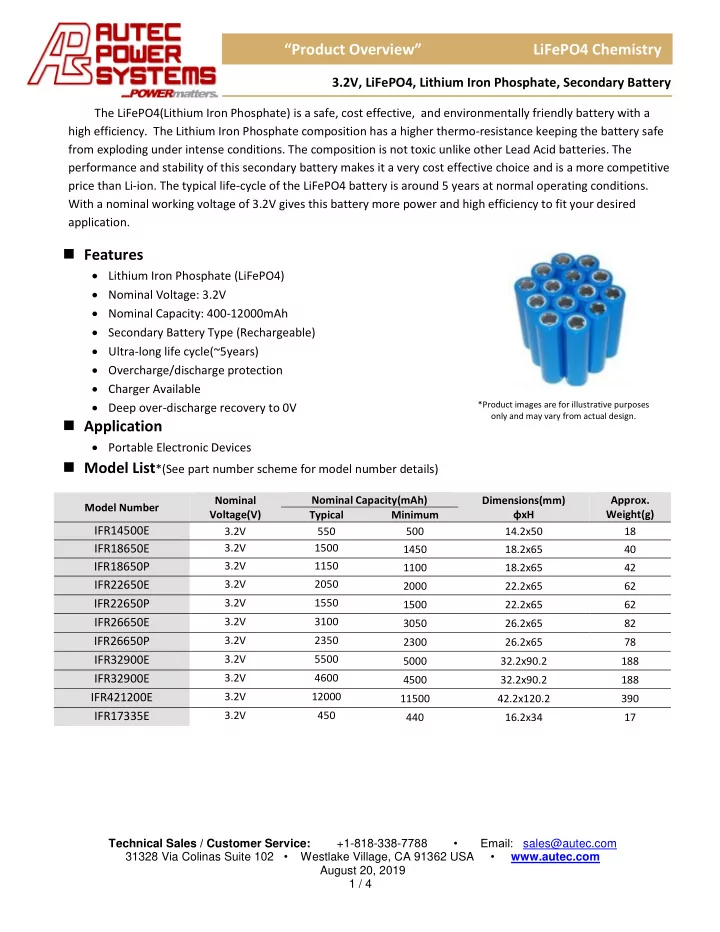

“Product Overview” LiFePO4 Chemistry 3.2V, LiFePO4, Lithium Iron Phosphate, Secondary Battery The LiFePO4(Lithium Iron Phosphate) is a safe, cost effective, and environmentally friendly battery with a high efficiency. The Lithium Iron Phosphate composition has a higher thermo-resistance keeping the battery safe from exploding under intense conditions. The composition is not toxic unlike other Lead Acid batteries. The performance and stability of this secondary battery makes it a very cost effective choice and is a more competitive price than Li-ion. The typical life-cycle of the LiFePO4 battery is around 5 years at normal operating conditions. With a nominal working voltage of 3.2V gives this battery more power and high efficiency to fit your desired application. ◼ Features • Lithium Iron Phosphate (LiFePO4) • Nominal Voltage: 3.2V • Nominal Capacity: 400-12000mAh • Secondary Battery Type (Rechargeable) • Ultra-long life cycle(~5years) • Overcharge/discharge protection • Charger Available • Deep over-discharge recovery to 0V *Product images are for illustrative purposes only and may vary from actual design. ◼ Application • Portable Electronic Devices ◼ Model List *(See part number scheme for model number details) Nominal Nominal Capacity(mAh) Dimensions(mm) Approx. Model Number Weight(g) Voltage(V) Typical Minimum ɸxH IFR14500E 3.2V 550 500 14.2x50 18 IFR18650E 3.2V 1500 1450 18.2x65 40 IFR18650P 3.2V 1150 1100 18.2x65 42 IFR22650E 3.2V 2050 2000 22.2x65 62 IFR22650P 3.2V 1550 1500 22.2x65 62 3.2V 3100 IFR26650E 3050 26.2x65 82 IFR26650P 3.2V 2350 2300 26.2x65 78 IFR32900E 3.2V 5500 5000 32.2x90.2 188 IFR32900E 3.2V 4600 4500 32.2x90.2 188 IFR421200E 3.2V 12000 11500 42.2x120.2 390 IFR17335E 3.2V 450 440 16.2x34 17 Technical Sales / Customer Service: +1-818-338- 7788 • Email: sales@autec.com 31328 Via Colinas Suite 102 • Westlake Village, CA 91362 USA • www.autec.com August 20, 2019 1 / 4
“Product Overview” LiFePO4 Chemistry 3.2V, LiFePO4, Lithium Iron Phosphate, Secondary Battery ◼ LiFePO4 Battery List(Standard) Nominal Nominal Dimensions(mm) Max Charge Max Discharge Model Number Voltage(V) Capacity(mAh) ɸxH Current(A) Current(A) 14500 0.4 3.2V 400 14.5x50.5 1.2 14500 3.2V 500 0.5 14.5x50.5 1.5 18500 3.2V 900 0.9 18.5x50.5 2.7 18500 3.2V 1000 1.0 18.5x50.5 3.0 18650 3.2V 1400 1.4 18.5x65.5 4.2 18650 3.2V 1500 1.5 18.5x65.5 4.5 22650 3.2V 2000 2.0 22.5x65.5 6.0 26650 3.2V 3000 3.0 26.5x65.5 9.0 3.2V 3200 3.2 26650 26.5x65.5 9.6 32650 3.2V 4000 4.0 32.5x65.5 12.0 32700 3.2V 5000 5.0 32.5x70.5 15.0 ◼ LiFePO4 Battery List(High Rate) Nominal Nominal Dimensions(mm) Max Charge Max Discharge Model Number Voltage(V) Capacity(mAh) ɸxH Current(A) Current(A) 0.4 18650P 3.2V 1100 18.5x65.5 1.2 26650P 3.2V 2300 0.5 26.5x65.5 1.5 ◼ Definitions The definition of a battery in Chemistry is an electrolytic device that directly converts the electrochemical energy of active ingredients into electrical power through electrochemical redox (oxidation-reduction) reactions. A Primary battery cannot be recharged and is discarded once it has expended its stored electrical energy. Conversely, a Secondary battery is capable of repeated use(rechargeable). Its charge may be fully restored by passing an electric current through the cell in the opposite direction to that of discharge, thus reversing the redox reactions. Common types of commercial Secondary batteries are as follows: 1. Sealed Lead Acid (SLA) 2. Nickel-Metal Hydride (Ni-MH) 3. Lithium-Ion (Li-Ion) 4. Lithium Polymer (LiPO) 5. Lithium Iron Phosphate (LiFePO4) Technical Sales / Customer Service: +1-818-338- 7788 • Email: sales@autec.com 31328 Via Colinas Suite 102 • Westlake Village, CA 91362 USA • www.autec.com August 20, 2019 2 / 4
“Product Overview” LiFePO4 Chemistry 3.2V, LiFePO4, Lithium Iron Phosphate, Secondary Battery Comparisons of Common Types of Commercial Secondary Batteries: Lithium Categories SLA Ni-MH Lithium-Ion Polymer Nominal Voltage 2.0 1.2 3.7 3.8 Energy Density - 250-300 250-350 250-400 Volumetric(Wh/I) Energy Density 25-45 50-80 100-150 100-150 Gravimetric (Wh/kg) 1. Deep charge & discharge 1. Can be discharged 1. Long life cycle Advantages 2. Mature at high current Long life cycle 2. Safe technology 2. Safe 3. Variety of sizes 3. Inexpensive 1. Expensive 1. Expensive 1. Memory Effect 2. Relatively unsafe 1. Slow charging 2. Poor Disadvantages 2. Poor performance 3. Poor 2. Short life cycle charge/discharge at high temperature charge/discharge at at high current high current Important note: By applying professional experience, knowledge, technical knowhow and continuous efforts by our engineering team, Autec brings domestically available, high-performance Lithium-Ion/Lithium Polymer, and LiFePO/LiFePO4 batteries that are capable of competing with the leading brands. Autec performs the following tests on our cells an batteries: No. Group B: Environment Test No. Group C: Safety Test 01 Short-Circuit 01 Temperature Cycling 02 Heating 02 Low Pressure 03 Abnormal Charge 03 High Temperature & Humidity 04 Overcharge External Circuit Design: 05 Impact 1. PCB 06 Crush 2. Battery Pack Balancer 07 Nail Penetration Technical Sales / Customer Service: +1-818-338- 7788 • Email: sales@autec.com 31328 Via Colinas Suite 102 • Westlake Village, CA 91362 USA • www.autec.com August 20, 2019 3 / 4
“Product Overview” LiFePO4 Chemistry 3.2V, LiFePO4, Lithium Iron Phosphate, Secondary Battery Autec Batteries have safety features with quality materials built in with the following: 1. High quality positive and negative electrodes 2. High quality separator material: Uniform thickness, and high mechanical strength. 3. Electrode workmanship: No sharp edges. 4. Keen attention to detail and quality workmanship throughout the assembly process for symmetry, uniformity, and consistent high quality. 5. Electrolyte: Characteristics and proportion of solvent substances, are verified. 6. Welding and stacking of cell tab for uniform length, impedance, position, and stacking method. 7. High quality sealing materials. 8. Industry standard cell tab packaging. For further information and technical application guidance, please contact Autec Technical Sales. Technical Sales / Customer Service: +1-818-338- 7788 • Email: sales@autec.com 31328 Via Colinas Suite 102 • Westlake Village, CA 91362 USA • www.autec.com August 20, 2019 4 / 4
Recommend
More recommend